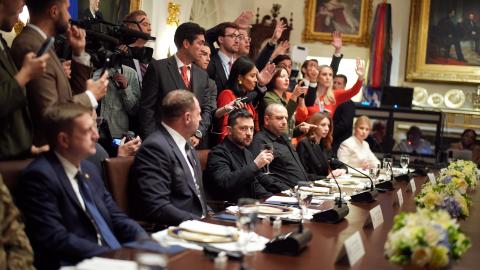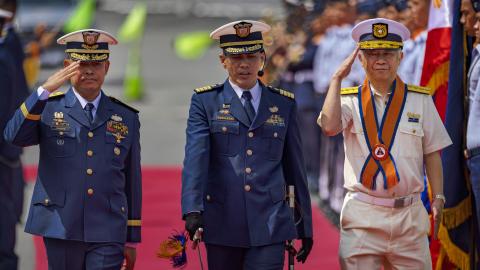Executive Summary
This paper is the second of a two-part series on the concept of the free and open Indo-Pacific (FOIP). The first study, The Rise of the Free and Open Indo-Pacific and the Challenge of Deterrence, examined the genesis of FOIP as well as its rise to strategic centrality for nations in the Indo-Pacific, North America, and Europe.
FOIP has made immense contributions to Indo-Pacific connectivity, prosperity, peace, and security. However, as our first study explores through a Hudson Institute tabletop exercise, FOIP has distinct limitations as a strategic doctrine. As a concept, it cannot bring friendly or less-friendly Association of Southeast Asian Nations (ASEAN) members to aid Taiwan if the small island nation faces what may be the most important strategic challenge in the region: a Chinese invasion or blockade.
FOIP nonetheless remains critical to promoting prosperity and connectivity in the Indo-Pacific. So herein lies the security paradox behind FOIP: It has the capacity to extend the network of partners and allies dedicated to Indo-Pacific security, which in turn will strengthen that security while reducing the United States’ security burden by extending it to other nations willing to defend themselves and their allies. Yet, for the time being, as FOIP is unable to prevent a Taiwan contingency, the ability to extend FOIP and expand America’s network of allies rests upon the foundation of the US deterrent.
In response to this situation, policymakers need to proceed along two simultaneous paths: construct institutions that promote FOIP and embed the countries of Southeast Asia and Oceania into the economic geography of the US, Japan, and Europe. Through these parallel developments, America would learn to listen to the needs of the ASEAN and Pacific Island nations while bringing them into a form of economic dependence on the US, Japan, and Europe that would parallel their growing dependence on and vulnerability to the People’s Republic of China.
As such, in this report, our policy recommendations focus on what we consider key strategic sectors: energy, semiconductors, and overseas economic development and investment. These are sectors in which Indo-Pacific nations have consistently asked for greater collaboration, and in which the United States and its allies have the greatest competitive advantage over China.
To sustain these efforts and to advance support for FOIP going forward, this report makes several recommendations as the conceptual approach necessary when engaging with the Indo-Pacific.
First, for FOIP to be effective, it should be adaptable. This largely entails careful design of the kinds of structures needed to address the region’s demands. Given the high rate of growth and sociopolitical change in the region, it is inevitable that structures, needs, and partners will change over time. Yet if FOIP-supporting nations continue to coordinate and collaborate on specific functional areas, they will be able to sustain their efforts regardless of such changes in Southeast Asia or elsewhere. Likewise, it is beneficial to design such structures as nongovernmental, which allows them to agnostically engage with a wide range of stakeholders from potential partner nations across government, industry, and civil society to deliver results.
Relatedly, FOIP initiatives should also react quickly to changing circumstances. Southeast Asian nations are reluctant to support FOIP in part because they want to avoid what they see as a superpower competition. As a result, American and allied outreach efforts are not likely to bear fruit consistently. However, instances such as the Philippines eagerly working with the United States, Japan, and other partners in the wake of Chinese aggression in the South China Sea mean that FOIP-supporting partners should develop a template for rapidly responding to potential new partners when opportunities arise. Tokyo and Washington’s speed in addressing Manila’s need for security through radar installations and reciprocal access agreements, as well as its economic needs through the Luzon Corridor and collaboration in semiconductors, is a paragon for how to make these changes going forward.
Third, to be truly successful, FOIP initiatives need to leverage all the disparate stakeholders in the Indo-Pacific to use the potential available from governments, the private sector, academia, and civil society. As mentioned previously, they should be ready to accommodate a shifting set of participants who have their own individual agendas and capabilities. This approach effectively uses the strength of the social cross-section among the FOIP-supporting nations. Their vibrant governments, businesses, universities, and civil societies demonstrate how the FOIP concept strengthens nations both abroad and at home. It is important that when they are developing solutions to problems in, say, LNG terminal financing, FOIP-supporting countries use their industry and technological assets. Doing so ultimately enhances intraregional economic cooperation, builds up diplomatic trust, and convinces the nations with the most at stake from a rules-based order in the Indo-Pacific to support FOIP.
Building a wider consensus for the FOIP across the Indo-Pacific is unlikely to be easy or direct; it will likely face political, economic, and security setbacks along the way. Yet the principles that undergird FOIP—the rule of law and the free flow of capital, goods, and people—have been responsible for the region’s rapid economic growth and success over multiple generations. The FOIP concept is a compelling message and a project worth working for; the United States and its allies should continue to put the utmost effort toward working together to support a winning idea.


















